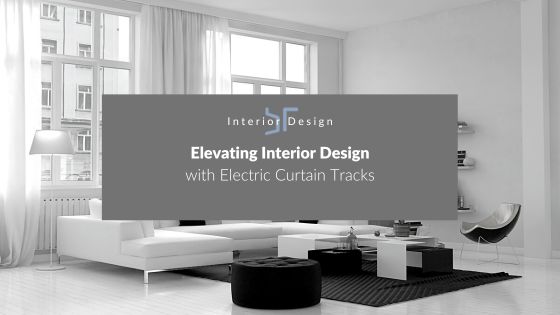Please wait...
Elevating Interior Design with Electric Curtain Tracks
This entry was posted 14/09/2023

In the realm of interior design, the pursuit of elegance, functionality, and innovation never ceases. Enter electric curtain tracks, a modern solution that has been making waves in the world of window treatments. These cutting-edge devices offer the luxury of effortlessly opening and closing curtains with a simple touch or even through voice commands. However, for discerning interior designers like yourselves, the choice between battery-powered and wired electric curtain tracks is a decision that demands careful consideration.
Battery-Powered Electric Curtain Tracks:
Battery-powered electric curtain tracks have redefined the possibilities in window treatment design. These ingenious devices provide all the advantages and automation of traditional electric curtain tracks, coupled with the flexibility of battery power. This liberates you from the constraints of complex electrical wiring or the need for nearby outlets. Whether you seek to enrich your clients' living spaces, enhance energy efficiency, or infuse a sense of modernity into your designs, battery-powered electric curtain tracks are a versatile and user-friendly solution. With the convenience of remote control and seamless integration into smart home systems, these tracks cater perfectly to the needs of today's tech-savvy homes. Bid farewell to manual curtain adjustments and usher in the future of window dressing with battery-powered electric curtain tracks. Now, let's explore the pros and cons through the lens of professional interior design.
Pros:
-
Ease of Integration: Installation of battery-powered curtain tracks is straightforward, allowing for a hassle-free setup in your design projects.
-
Flexibility in Placement: Since these tracks don't rely on a wired connection, they offer unmatched flexibility. Easily relocate them to different areas without the complexities of rewiring.
-
Cost Efficiency: Battery-powered tracks are often a more cost-effective initial investment as they don't necessitate professional installation or wiring.
Cons:
-
Battery Management: The primary drawback is the need for periodic battery replacement, which depends on usage. This ongoing maintenance and cost consideration may influence your customers decisions.
-
Weight and Size Limitations: Battery-powered tracks may not be suitable for heavier or larger curtains, potentially impacting their smooth operation.
Wired Electric Curtain Tracks:
For the professional interior designer seeking the pinnacle of precision and convenience in curtain control, wired electric curtain tracks represent a remarkable advancement. These sophisticated systems seamlessly integrate into your designs, providing a reliable and constant power source through hardwired connections. This unwavering functionality makes them the ideal choice for designers aiming for a seamless and dependable solution in their interior projects. In this exploration, we will delve deeper into the world of wired electric curtain tracks, unraveling their benefits, applications, and their potential to elevate both your design aesthetics and your clients' daily lives. Welcome to the future of curtain control with wired electric curtain tracks.
Pros:
-
Reliability: Wired curtain tracks are highly dependable, powered consistently through wired connections, and capable of handling even the most substantial curtains with ease.
-
Customization: Wired systems often offer extensive customization options, enabling seamless integration into your design concepts or remote control via dedicated apps.
-
Maintenance-Free: As they do not rely on batteries, wired tracks spare you from concerns about frequent replacements or recharging.
Cons:
-
Professional Installation: Wired tracks require professional installation, which may entail higher costs and a more intricate setup process compared to battery-powered alternatives.
-
Limited Mobility: Once installed, wired tracks are less flexible in terms of relocation, a consideration to weigh in your design planning.
Choosing the Right Track for Your Design Vision:
For professional interior designers like yourselves, the decision between battery-powered and wired electric curtain tracks hinges on your specific design objectives:
-
If you prioritise flexibility, adaptability, and cost-effectiveness in your projects, battery-powered tracks may align with your vision.
-
If your design philosophy revolves around reliability, customisation, and long-term client satisfaction, wired tracks may serve as the superior choice.
Consider elements such as curtain size, weight, budget, and the potential for seamless integration with home automation when making your decision. Ultimately, both options offer avenues to enhance the comfort and aesthetic appeal of your interior design projects.
Whether you opt for battery or wired electric curtain tracks, both provide a modern and convenient solution for elevating the curtain aspect of your designs. Your choice should harmonize with your design philosophy and the unique needs of your clients, resulting in more captivating and efficient living spaces.
This entry was posted on 14/09/2023





